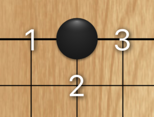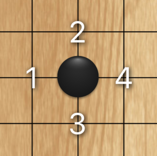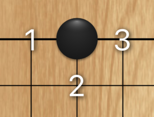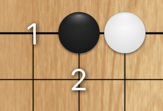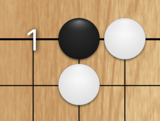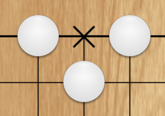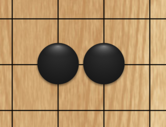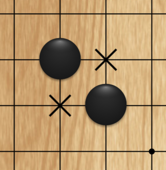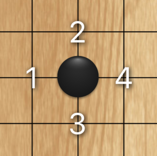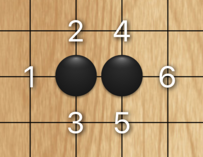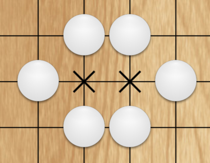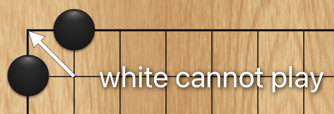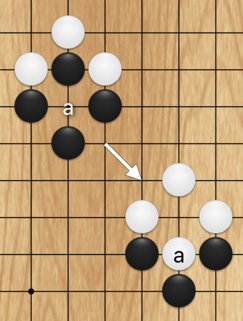Go rules
This help section contains only a barebones introduction to the rules of Go. For a more thorough treatment please visit one of the many websites dedicated to the game. For instance, an excellent resource is Sensei’s Library while another more hands-on interactive tutorial is available on online-go.com.
The game is played by two players. One of them plays with black stones, the other with white stones. Usually black makes the first move, except when there is a handicap. This introduction does not cover handicap.
The board is a grid of horizontal and vertical lines. The standard board size is 19x19, but smaller board sizes are good for teaching games or solving special Go problems. Little Go allows you to set any board size between 7x7 and 19x19. Only board sizes with an odd number of lines are supported to ensure that there is a center point.
The lines of the board have intersections wherever they cross or touch each other. Each intersection is called a point. That includes the four corners, and the edges of the board. Stones are placed on points (intersections), which might seem unusual if you are coming from chess.
Players take alternate turns. When it is their turn, they make a move. A move usually consists of placing a stone. However, a player may also decide to pass, in which case it is the other player’s turn. If both players pass, the game is over and the score is calculated to determine who has won the game.
Note that stones can only be placed on empty points. Also note that it is not possible to move a stone once it has been placed.
Each point (intersection) on the board has a number of lines leading away from it to adjacent points. When a stone is placed on a point, the number of lines leading away from it to unoccupied adjacent points are called its “liberties”.
For instance, if a stone is placed in a corner at the start of the game it has 2 liberties, if it is placed on an edge line it has 3 liberties, and if it is placed somewhere in the middle of the board it has 4 liberties.
Enemy stones that surround one of your stones take away liberties from that stone. If your stone has no liberties left it is captured. The opponent removes your stone from the board and places it in a box where at the end of the game it can be used for scoring. The point where your stone was is now unoccupied once more.
If you place stones next to each other so that they are connected through the lines leading away from the points they occupy, they form a stone group. Stones that are adjacent to each other diagonally are not connected through lines and therefore do not form a stone group.
Stones in a group share their liberties. For instance, if you place a stone somewhere in the middle of the board it initially has 4 liberties. If you now place another stone on an adjacent point the two form a stone group and together have 6 liberties.
Stones in a group must be captured as a group, i.e. the opponent must surround the entire group and take away all of its liberties before they can capture it. If they succeed they capture the entire group and remove all stones from the board.
It is forbidden to place a stone so that it has no liberties. For instance, it is forbidden to place a stone on a point that is surrounded on all sides by enemy stones.
By extension, it is also forbidden to place a stone if it connects to a stone group and the entire stone group would have no liberties left.

The exception to the Suicide rule is: You are allowed to place a suicidal stone if by placing it it takes away the last liberty of one or more enemy stones, thus making liberties for its own.
It is forbidden to play a move which repeats a previous board position. This rule prevents endless repetition in the face of alternating capturing moves due to the exception to the Suicide rule.

Note that if some other moves are played in between, the same play may be available again as a legal move, because it will not be repeating the same board position.
This rule is also called the “ko” rule.
Taking all the above rules into account, it is possible to form stone groups that are impossible to capture under normal, alternating game play (also assuming the defending player makes no mistakes). If such a group is formed it is called “alive”. A group that lives usually surrounds two or more separate areas of empty points. These areas are called “eyes”.

The concepts of “life” and “eyes” are not actually rules, they are just a natural consequence of following the three rules about liberties, suicide and ko. Nevertheless, it is essential to understand “life” and “eyes” to become better at playing Go. Playing a few games, making mistakes and learning from them usually is the best teacher.
The purpose of the game is to occupy or surround more points than the opponent. When the game ends (both players pass), your score is calculated according to the scoring system that you and your opponent agreed upon before the game started.
For area scoring (the default in Little Go), calculate your score as follows:
- First, remove all dead stones from the board (your own, but also those of your opponent). Stones are dead if they are not “alive”, i.e. if they could be captured if you were to continue playing. After removal, calculate your score as follows.
- The number of your stones on the board.
- Plus the number of empty points only your stones surround.
Your opponent’s score is calculated in the same way, only from his point of view. Whoever plays white adds komi to his score (komi is usually 7½ and is given to the white player as a bonus to compensate for the black player’s advantage of first move).
Whoever now has the higher score wins the game.
For territory scoring (the other major scoring system), calculate your score as follows:
- The number of enemy stones that you captured during the game
- Plus the number of enemy dead stones on the board completely surrounded by your stones. See above for a short definition of when stones are dead.
- Plus the number of points completely surrounded by your stones, regardless of whether they are empty or occupied by enemy dead stones.
- Komi is usually 6½ for territory scoring
An important note about dead stones: You and your opponent must agree on which stones are dead! If your opponent does not agree with your judgment, you must continue the game until the situation in doubt has been settled to both players' satisfaction. While you are new to the game you often will not see what the final outcome of a situation in doubt will be, so you will spend a lot of time in the end game on playouts. This is perfectly OK because you will learn from the experience. Once you get more experienced, though, less situations will have to be played out, making the end game less time consuming (and possible less tedious for your more experienced opponent).
Some of the pleasure of playing Go (when played against a fellow human) comes from following certain points of etiquette that have developed over the long history and tradition of the game. In Little Go, most of the time you will play against the computer, so there is not much point in going into the details of this subject. If you are keen on reading more, though, have a look at this article on Sensei’s Library.

